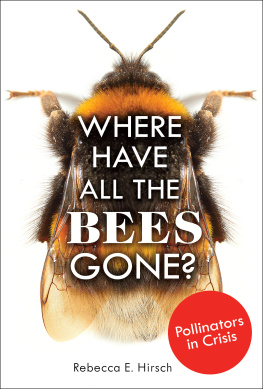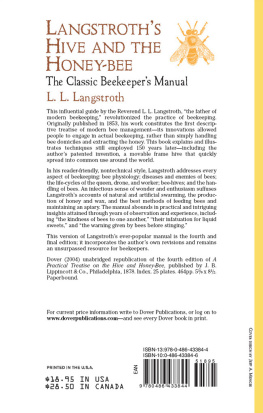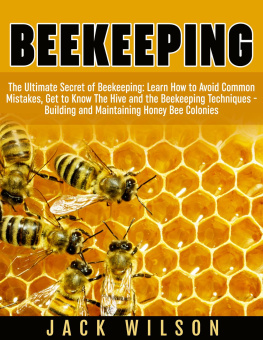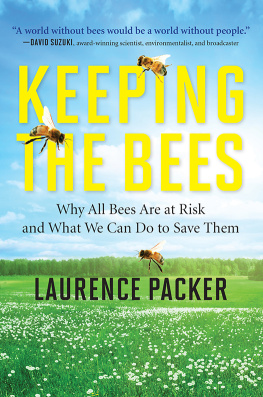Writing a book is never achieved without considerable help from friends and colleagues. I would like to acknowledge the help of Professor C. L. Scudamore, Royal Veterinary College London and Iain MacMillan, Glasgow University, Dr Ke-Jein Chen, the staff at the Animal Technology Research Institute Taiwan in particular Professor Shih Ping Chen and Dr Chuan Hsing Chang for the preparation of the stained bee sections.
To the Nakasongola Apiculture Training Centre, Gulu Road, Nakasongola, Uganda for their very generous help with their bees; they could not do enough to help me with this and other projects. If any enthusiast is passing please call in and visit the institute.
To Jakob Hoffer, Starlite Colony, Manitoba for lending me a hand during the making of this book.
To Howells Veterinary Services and the North Park Veterinary Group.
To Sunjin Korea and the Philippines for allowing me to work with their hives.
To Dan Martin, DPI Victoria, Australia who showed me some of Australias extensive biosecurity preparations to protect their bee (farmed and native) populations.
To Alice, our queen for allowing me to take numerous photographs of her and her subjects.
To Cath Fraser MRCVS who provided critical comment when required.
To all the staff at 5M who have helped put this book together.
Thanks to Linda for putting up with me over the years.
- Adey, M., Walker, P. and Walter, P.T. (1986) Pest Control Safe for Bees. A manual and directory for the tropics and subtropics. ISBN 0-86098-184-3
- Aston, D. and Bucknall, S. (2010) Keeping Healthy Honey Bees. ISBN 978-1-904846-54-3
- Bailey, L. (1981) Honey Bee Pathology. ISBN 0-12-073480-X
- Basic Beekeeping Manual 1 (2009) Gregory Pam Manual sponsored by the waterloofoundation
- Beekeeping Study Notes for the Bee Keeping Exams. ISBN 0-905652-33-9; ISBN 0-905652-34-7; ISBN 0-905652-21-5 and ISBN 0-905652-35-5
- Boucias, D.G. and Pendland, J.C. (1998) Principles of Insect Pathology. ISBN 0-413-03591-X
- Canadian Association of Professional Apriculturists (2013) Honey bees diseases and pests, 3rd edn. ISBN 978-0-96933336-16, available online at www.capabees.org
- Chapman, R.F. The Insects: Structure and Function (1998). ISBN 978-0-521-57048-0
- Cullum-Kenyon, I.D. and Cullum-Kenyon, R. (2012) The BBKA Guide to Beekeeping. ISBN 978-1-4081-5458-8
- Dade, H.A. (1994) Anatomy and Dissection of the Honey Bee. ISBN 978-0860982142
- Davis, C. (2004) The Honey Bee Inside Out. ISBN 978-900147-10-4
- Dietemann, V., Ellis, J.D. and Neumann, P. (2013) Coloss Beebook Volumes I and II. Standard methods forApis mellifera research. ISBN 0-85098-274-2 2013
- Edwards, M. and Jenner, M. (2005) Field guide to the Bumblebees of Great Britain and Ireland. ISBN 978-0-954971311
- Erickson, E and Carlson, S.D. (1986) A Scanning Electron Microscope Atlas of the Honey Bee. ISBN 978-0813805467
- Fisher, R.L. (2010) Bee. ISBN 978-61689-076-6
- Flottum, D. (2005) The Backyard Beekeeper. ISBN 10-1-59253-118-0
- Goodman, L. (2003) Form and Function in the Honey Bee. ISBN 0-86098-243-2
- Goulson, D. (2010) Bumblebees: Behaviour, Ecology and Conservation. ISBN 978-0-19-955307-5
- Graham, J. (1992) The Hive and the Honey Bee. ISBN0-915698-09-9
- Grimaldi, D and Engle, M.S. (2005) Evolution of the Insects. ISBN 978-0-521-82149-0
- Hepburn, H, Randall, R., and Radloff, E.E. (2011) Honeybees of Asia. ISBN 978-3-642-16421-7
- Hepburn, H.R., Rirk, C.W.W. and Duangphakdee, O. (2014) Honeybee Nest. ISBN 978-3-642-54327-2
- Herrod-Hempsall, W. (1943) The Anatomy, Physiology and Natural History of the Honey Bee. ASIN: B0007JNEJI
- Honey Bee Health. USDA Website, available online at www.ars.usda.gov/ccd
- Jalil, A.H. (2014) Beescape for Meliponines. ISBN 978-4828-2361-5
- Kirk, W. A. (2006) A Colour Guide to Pollen Loads of the Honey Bee. ISBN 10-86098-248-3
- Koeniger, K., Koeniger, G. and Tingek, S. (2010) Honey bees of Borneo. ISBN 978-983-812-128-0
- Kugonza, D.R. (2009) Beekeeping Theory and Practice. ISBN 978-9970-02-965-5
- Mann, D.I. (1976) Bees are wealth a handy guide to bee-keeping in East Africa. ISBN 9966-44-090-9
- Marchand, D. and Marchard-Mayne, J. (2003) Beekeeping. A practical guide for southern Africa. ISBN 0-9584564-2-9
- Maurer. B. (2012) Practical Microscopy for Beekeepers. ISBN 978-0-900147-13-5
- McMullan, J. (2012) Having Healthy Honey Bees. An integrated approach. ISBN 978-0957135505
- National Bee Keeping Training and Extension Manual (March 2012). Funded by the African development bank and government of Uganda
- Oldroyd, B.P. and Wongsiri, S. (2006) Asian Honeybees. ISBN 0-674-02194-0
- Peacock. P. (2008) Keeping bees. ISBN 978-0-7938-0669-0
- Penn State University. (2011) A field guide to Honey Bees and their Maladies
- Preston, C. (2006) Bee. ISBN 10-1-86189-256
- Prys-Jones, O.E. and Corbet, S.A. (2011) Bumblebees. ISBN 978-1-907807-06-0
- Root, A.I. (2007) The ABC and XYZ of Bee Culture. ISBN 978-0-936028-22-4 (from 1877)
- Sammataro, D. and Avitabile, A. (1978) The Beekeepers Handbook. ISBN 978-0-8014-8503-9
- Sammataro, D. and Yoder, J.A. (2012) Honey Bee Colony Health. Challenges and Sustainable Solutions. ISBN 978-14398-794-05
- Seeley, T.D. (2010) Honeybee Democracy. ISBN 978-0-691-14721-5
- Snell, I. (2012) Understanding Bee Anatomy: A Full Colour Guide. ISBN 978-0-9574228-0-3
- Snodgrass, R.E. (1953) Anatomy of the Honey Bee. ISBN 978-0-8014-9302-7
- Tautz, J. (2008) The Buzz About Bees. ISBN 978-3-540-78727-3
- Thomas, D. (2012) The healthy bee hive. ASIN: B008WARIZU
- Varroosis, Tropilaelaps, Small Hive Beetle, Foulbrood. Series of booklets published by DEFRAUKFERA.
- Vega, F.E. and Kaya, H.K. (2012) Insect Pathology, 2nd edn. ISBN 978-0-12-384984-7
- Vidal-Naquet., N. (2015) Honeybee Veterinary Medicine: Apis mellifera L. ISBN 978-1-91945-504-3
- Warring, C. and Warring, A. (2011) Bee Manual. ISBN 978-0-85733-057-4
- Wilson-Rich, N. (2014) The Bee. A Natural History. ISBN: 978:1-78240-107-0
- Wiscombe, D. and Blackiston, H. (2012) Beekeeping for Dummies. ISBN 978-1-119-97250-1
- Woodward, D. (2010) Queen Bee: Biology, Rearing and Breeding. ISBN 978-0-473-11933-1
Introduction and anatomy of bees
Apart from providing mankind with honey and a whole host of products, the crops that we rely on are pollinated by bees to provide us food. In parts of the world, bee pupae may also be harvested as a food source.

Figure 1.1 Honey bees working almond blossom
The annual almond crop in the USA alone requires 1.3 to 1.5 million hives thats 200,000 million bees!
Honey bees have been introduced around the world, most notably in North America and Australia, and they have become vital to our food source.
They also aid in providing us the beauty of our flowering gardens.
Native Americans knew that the Europeans were coming when they started seeing Apis mellifera on flowers. They called our majestic bee white mans flies.
Bees are farmed around the world and their products are used on a worldwide basis. With the changing world of economics and globalisation there has been a similar change in honey production around the world over time. As countries develop so will their honey production.














